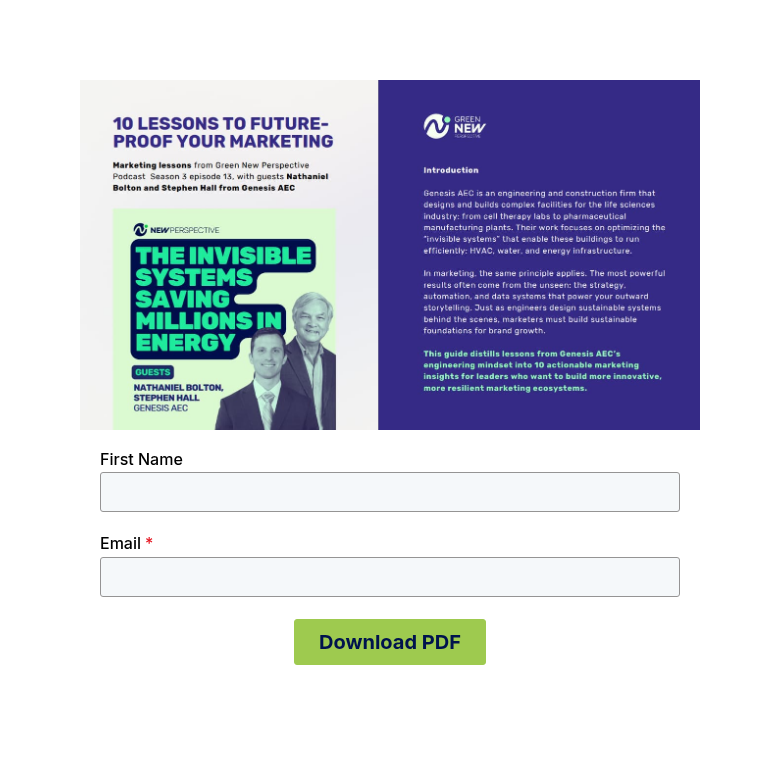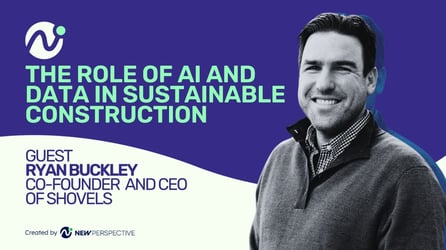Episode Info
When people talk about sustainability, the conversation often drifts toward the visible symbols: solar panels, wind turbines, and electric vehicles. But for Stephen Hall and Nate Bolton of Genesis AEC, the real opportunity for change lies behind the walls and under the floors, in the invisible systems that keep facilities running.
Genesis AEC, an engineering and construction firm headquartered in the Philadelphia and Boston areas, specializes in designing and building facilities for the life sciences industry. Their work touches everything from cell therapy labs to pharmaceutical production plants, and increasingly, their focus is on making these environments more sustainable.
Interview with Nathaniel and Stephen
Dunja Jovanovic: Stephen, let’s start with you. For those who aren’t familiar, what is Genesis AEC, and what kind of work do you do?
Stephen Hall: I’m the Chief Process Engineer at Genesis AEC. We design and construct facilities for the life sciences: everything from cell therapy to pharmaceutical manufacturing. My role is to oversee the process engineering aspects. I’m a chemical engineer by training and have spent my career focused on how these systems can be designed to be efficient, reliable, and increasingly, sustainable.
DJ: And Nate, how about your role?
Nathaniel Bolton: I’m on the mechanical engineering side. I focus on HVAC design and how we implement those systems in the kinds of facilities Stephen mentioned. It’s not flashy work, but it’s essential to how efficiently these buildings perform.
DJ: Stephen, you’ve called systems like water, energy, and air handling “invisible levers” for sustainability. Why?
SH: Because they’re literally the bones of the building. You don’t see them when you walk through a facility, but they drive how efficiently that building operates. In any lab or production space, systems like chilled water, steam, or pure water are the heart of energy use. Managing them well is where we can make the most significant impact on conservation and carbon footprint.

DJ: Nate, when we think about sustainability, people tend to focus on what’s visible: solar panels, EV fleets, green roofs. Why do these invisible systems matter just as much?
NB: Because the visible systems depend on them. Your solar panels or wind power might provide energy, but if your building is inefficient, you’ll always need more of those. When you make your HVAC and water systems more efficient, you reduce your energy demand, which means fewer, more expensive systems on the supply side. It’s a win-win.
DJ: You’ve both mentioned air handling as a primary focus. Why is that such a big deal in your industry?
NB: In life sciences, air is everything: it controls cleanliness, safety, and comfort. But it’s also one of the facility's biggest energy users. If we can safely reduce airflow rates or use more innovative controls to match air delivery to actual need, the savings are enormous. It’s often the first place we look when helping clients become more sustainable.
SH: Humidity and temperature control matter too. Human comfort and process stability depend on both. Using automation and algorithms to fine-tune those set points means we can cut energy use without changing the air volumes that are needed for safety. It’s all about more intelligent control, not more equipment.
DJ: What’s one common misconception companies have when they try to make their facilities more sustainable?
SH: There’s often a disconnect between corporate sustainability goals and what’s actually achievable in a facility. Top management sets big targets —net zero carbon and water reduction —but the engineers on the ground have to implement them with limited budgets and technical constraints. Sometimes the goals sound great on paper but aren’t realistic in practice.
DJ: Data is such a buzzword in sustainability conversations. How does it really come into play in your work?
NB: Data is powerful, but only if it’s good data. It’s not about collecting everything; it’s about collecting the right things. Too often, companies have sensors and control systems but don’t analyze the information meaningfully. You need to know which data points actually tell you whether your system is performing efficiently.
SH: And even when the data is there, people don’t always use it. I’ve seen clients get monthly reports full of performance metrics that no one ever acts on. Turning that information into decisions — that’s the real challenge.
DJ: Cost is always part of the conversation. How do you help clients balance sustainability goals with financial realities?
SH: It’s a tremendous tension. Costs almost always drive decisions. Companies start projects with ambitious sustainability targets, but when estimates come in, the scope gets scaled back, or the project dies. We can model and advise, but at the end of the day, it’s their call.
NB: That’s why we try to reframe sustainability as an investment, not an expense. It’s like buying boots: spend more upfront on a good pair that lasts ten years, or buy the cheap pair you’ll replace every few months. The same logic applies to building systems: long-term value beats short-term savings.
DJ: Stephen, can you tell us about PharmaWater Pro and how it fits into this work?
SH: PharmaWater Pro is a software platform we developed to help clients evaluate their water purification systems. Every pharmaceutical facility needs purified water, but there are several technologies available, and the best choice depends on factors such as local energy costs, water usage, and maintenance needs. The tool models those variables and shows which option is most sustainable and cost-effective. It helps clients make smarter, faster decisions — without reinventing the wheel each time.
DJ: If you imagine a facility ten years from now, what does it look like?
NB: I think we’ll see something like an industrial version of the Passive House — buildings designed from the ground up for efficiency, not just retrofitted for it later. Everything will be connected —from sensors to controls —by people trained to understand and optimize those systems.
SH: And collaboration will be critical. These systems —boilers, chillers, water treatment —often involve multiple vendors with their own goals. We need project managers who can bridge those gaps and align everyone around shared sustainability outcomes.
DJ: What kind of mindset shift would you like to see across the industry?
NB: Moving away from “first cost” thinking. Stop judging systems solely by their purchase price and start looking at lifecycle costs: performance, reliability, longevity.
SH: And we need precise, trusted data to make that case. Numbers that prove sustainable choices are also wise business choices.
👉 Episode Resources:
- Website: https://www.genesisaec.com/
- LinkedIn: https://www.linkedin.com/company/genesis-aec/



